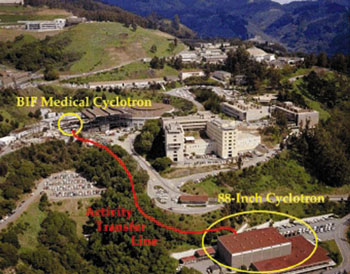
Understanding how the strong force binds nucleons together to form light nuclei and how stars synthesize heavier nuclei is fundamental to our comprehension of the universe. The study of stable and unstable nuclei leads to an improved knowledge of nuclear structure, the limits of nuclear stability and the nature of interactions between protons and neutrons. Accelerator-produced radioactive species will provide a critical source of proton- and neutron-rich nuclei to further these studies.
Lawrence Berkeley National Laboratory’s Berkeley experiments with accelerated radioactive species (BEARS) project has achieved a major goal with the delivery of its first radioactive beam – 1-2 x 108 ions/s of 110 MeV carbon-11 onto a gold target for a period of 4 h for a study of the yields of astatine isotopes. BEARS is led by Joseph Cerny, Professor of Chemistry at the University of California and LBNL Nuclear Science Division, with other researchers from the Nuclear Science Division, the Life Sciences Division of LBNL and from the Brookhaven National Laboratory. The project produces radioactive beams, for use in nuclear studies, at a modest cost by using existing cyclotrons. Efforts are focused on this coupled cyclotron approach, which uses one cyclotron to produce a radioactive isotope and a second one to accelerate it.
The group began proof-of-principle experiments using carbon-11 with a half-life of 20 min. The carbon-11 is made at Berkeley’s 88 inch cyclotron by bombarding nitrogen-14 with protons. The carbon-11 combines with a small amount of oxygen to form CO2. This was transported by gas jet to a reservoir near the electron cyclotron resonance ion source (ECR) and cryotrapped with liquid nitrogen while the carrier gas was pumped away. The trap was then warmed up and the carbon-11 was fed into the ECR to test the efficiency of the ion extraction. The ions were extracted. However, the efficiency was low.
The next step was to produce batches of carbon-11 at the Biomedical Isotope Facility cyclotron, which is an 11 MeV, 30 µA proton machine. Higher yields were achieved using a high-pressure gas target and the higher beam currents available. The carbon-11 (as CO2) was trapped in a coiled stainless steel tube submerged in liquid nitrogen and brought by truck to the 88 inch cyclotron. The liquid-nitrogen trap was warmed and the carbon-11 was fed into the advanced ECR (AECR) source, ionized and extracted, with 10% efficiency, as a 4+ charge beam of ions. The carbon-11 was injected into the 88 inch cyclotron and the beam was tuned using 8+ neon-22. After the beam optics had been completed with neon, the cyclotron’s radiofrequency was shifted a few kilohertz to bring carbon-11 into resonance. A foil before a key bending magnet completely stripped the ions of electrons. This allowed the separation of contamination from the ECR source. The typical extracted beam speed was 3 x 107 ions/s.
With the success of these experiments, the construction of a 300 m transfer line between the two cyclotrons was begun. Previous tests had shown that the transfer time over this distance was 20 s. A 150 mm rigid outer pipe was installed between the cyclotrons about 1 m off the ground with access boxes every 30 m. Then a 50 mm vacuum hose was pulled through the pipe. Finally, a bundle of capillaries, varying in size from 3 to 10 mm in diameter, was pulled through the 50 mm hose. The pressure in the hose was maintained at 1 Torr. The integrity of the system was monitored for pressure loss, continuity and radiation levels. This system exceeds stringent laboratory safety requirements. The BEARS group also worked closely with the Environmental Health and Safety Division. Close co-operation among all three divisions was instrumental in the project’s success.
On completion of the transfer line, a successful commissioning run used carbon-11 in the form of CO2, which was produced at the Biomedical Cyclotron and released in batches of 3 x 1013 molecules down the transfer line at 5 min intervals. At the 88 inch cyclotron the CO2 was caught in a cryotrap and slowly released into the AECR. The entire process was automated and was controlled and monitored by computer. Between 1 and 2 x 108 ions of 11 C/s were available on target.
Future plans will envolve the development of other short-lived radioactive beams, which will include nitrogen-13, oxygen-14, and fluorine-17 and -18 for nuclear physics and nuclear astrophysics experiments.







